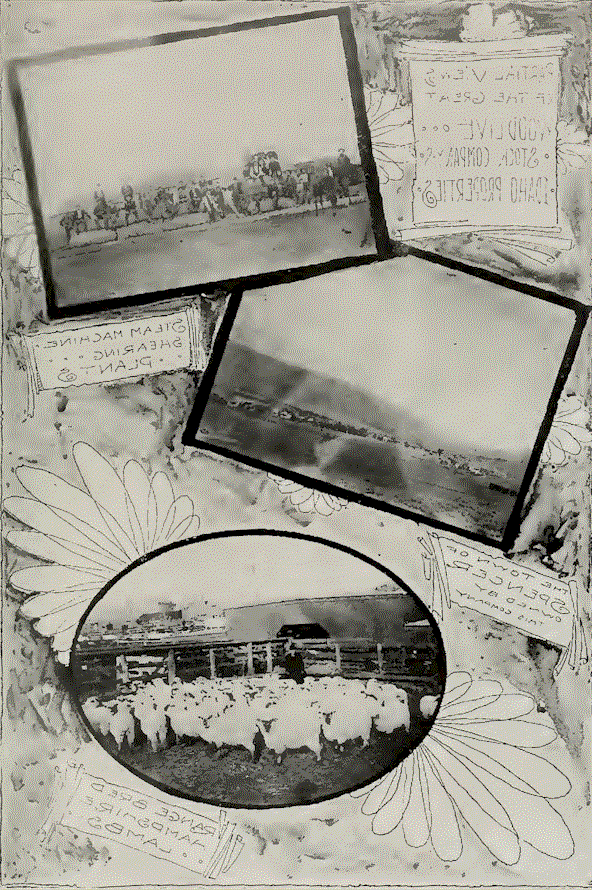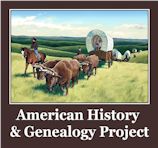Wood Livestock Company, Spencer, Idaho
In the early '80's the late J. D.
Wood, who was at that time mining in Idaho, began the
acquirement of land in Custer and Fremont counties with a view
to developing a small livestock interest. In his youth and early
manhood he had bought cattle throughout Missouri and Illinois
and driven them to the Chicago market, thus acquiring a
knowledge and taste for the livestock business which at a later
date bore abundant fruit.
Mr. Wood's original intention was to
engage in the cattle business, but, owing to the extremely high
price of cattle at that time, he decided to try sheep. His first
venture was the bringing overland by trail from Umatilla County,
Ore., of 6,000 head of young ewes. These he placed upon the
range near his ranch in Pahsimaroi Valley, a tributary to Salmon
River, Custer County, Idaho.
In 1887 Mr. Wood sold a one-fourth
interest in his livestock business to his stepson, F. J.
Hagenbarth, who assumed the management of those interests. The
business steadily grew until 1896, when the company was
incorporated as the Wood Live Stock Company, at which time Mr.
H. C. Wood and J. Barnett acquired interests in the property.
The years 1893 to 1896, inclusive,
were very lean years for sheep husbandry, owing to the passage
of the Wilson Bill, which removed the duty from wool. However,
in 1896, Mr. Wood and the others interested, being firm
believers of the election of Mr. McKinley and of the
inauguration of a protective tariff era, had trailed up from
Oregon over 50,000 head of young ewes. The sheep were bought at
an average price, laid down in Idaho, of $1.35. Immediately
after the election, during the months of November and December,
the company disposed of a large number of these sheep at $3.50
and $4.00 per head.
The following years were very
prosperous, and in 1900 the capital stock of the company was
increased to $500,000, fully paid up. During the interim since
the beginning of the business, the company began the systematic
acquirement of lands and had extended their operations so as to
cover parts of Custer and Lemhi counties and had acquired
interests in Bingham, Blaine and Fremont counties.
One reason of the great success
attained by Mr. Wood and associates in the live-stock business
was their early realization of the fact that young lambs four
months old could be shipped from the Western ranges to the
Eastern markets and sold at approximately as high a price as two
or three year old wethers. The company engaged in this business
on a large scale and were shipping many trainloads per annum.
The present year, 1909, the company will sell on the Chicago
market upwards of 60,000 head of young lambs, which will net
them, all expenses paid, about $3.50 per head.
In conjunction with the growing of
lambs for the mutton trade the company has imported from England
into the United States the best strains of mutton blood
obtainable in England. They now have on their range, near
Spencer, Idaho, the largest and best flock, size considered, of
pure registered Hampshires in the world. The lambs from this
flock readily top the Eastern market.
The Wood Live Stock Company was the
first concern to introduce on the open range the shearing of
sheep in large numbers by the use of machinery. They had in
operation last year three of these plants, two in Idaho and one
in Montana.
Since 1900 the company has extended
the area of its activities into Madison and Beaver Head
counties, Montana, where they have acquired extensive
real-estate and range holdings. At the present time it owns in
fee simple and controls by lease or otherwise, around 100,000
acres of choice farming and grazing lands in Idaho and Montana.
The summer range is located along a spur of the Rocky Mountains
lying southwesterly from the Yellowstone National Park. The
headquarters and general offices of the company are at Spencer,
Idaho. The company practically owns this town where it has
erected a large three-story office and commissary building and
has built cottages for the use of the foremen and their
families. Its buildings can be readily distinguished by their
color, which is uniformly yellow trimmed with white. Here the
organization and system which prevail throughout the activities
of the company can be readily noticed. The commissary department
in itself is interesting. Everything that could be required for
use on the range or ranch is there to be found in quantity.
Canned stuffs, sugar, etc., are bought in carload lots and
distributed from this point. Hardware, machinery, wagons, etc.,
are kept in quantity. The company manufactures its own sheep
wagons, which are models of convenience and comfort.
In addition to the sheep interests,
the company is engaged in a large way in the breeding of horses
and the handling of cattle. They were likewise largely
interested in the cattle and lamb business in Old Mexico. These
interests have, however, been recently sold.
The personnel which comprises the
actual management of the company at the present time is as
follows: F. J. Hagenbarth, president and manager (Mr. Hagenbarth
succeeded the late J. D. Wood as president); Mr. H. C. Wood,
vice-president and assistant manager; Mr. J. Barnett, treasurer;
Mr. C. W. Hardy, secretary; Mr. John W. Hart, director and ranch
superintendent; Mr. Sam Sample, range superintendent.
At the present time the net resources
of the company amount to about $2,000,000. The annual output in
the way of wool, mutton, cattle, horses and products of various
kinds from the ranches will approximate $500,000. The annual
pay-roll and expense account is about $200,000.
The brief history of this company is
the best possible commentary that could be had on the
opportunities and possibilities of acquiring wealth and
permanent interests that have been and are still afforded by the
magnificent State of Idaho. Mr. J. D. Wood's original investment
in the ranch and live-stock business, when inventoried in 1885,
amounted to only $20,000.


Index

Source: Sketches of the Inter-Mountain
States, Utah, Idaho and Nevada, Published by The Salt Lake
Tribune, Salt Lake City, Utah, 1909
|


